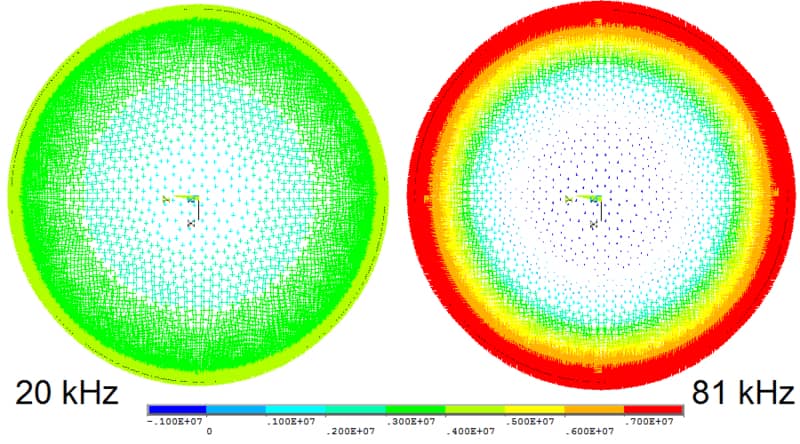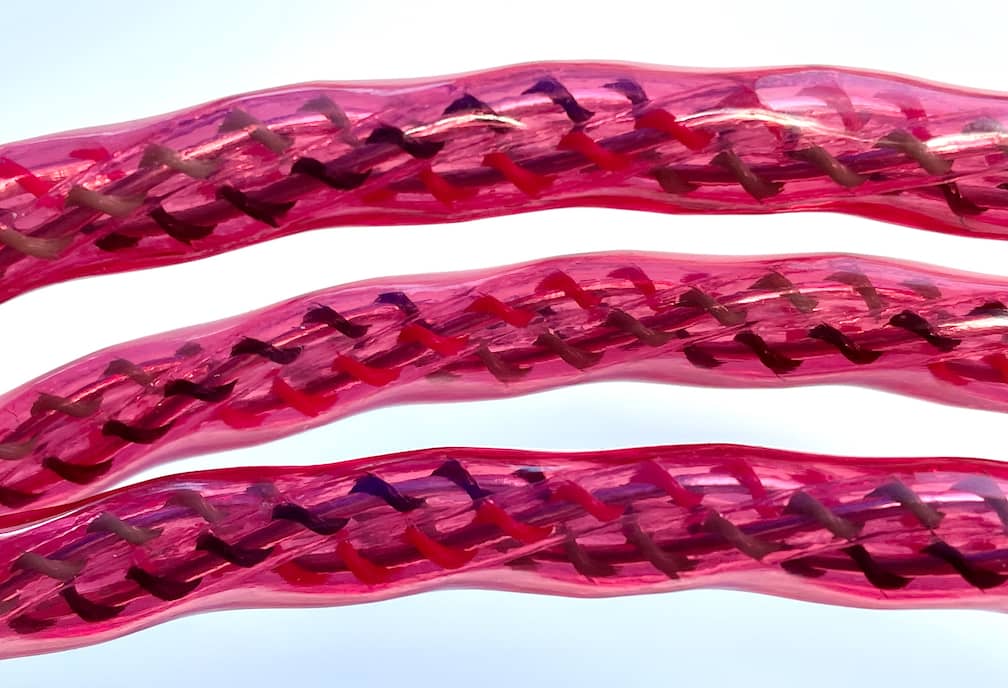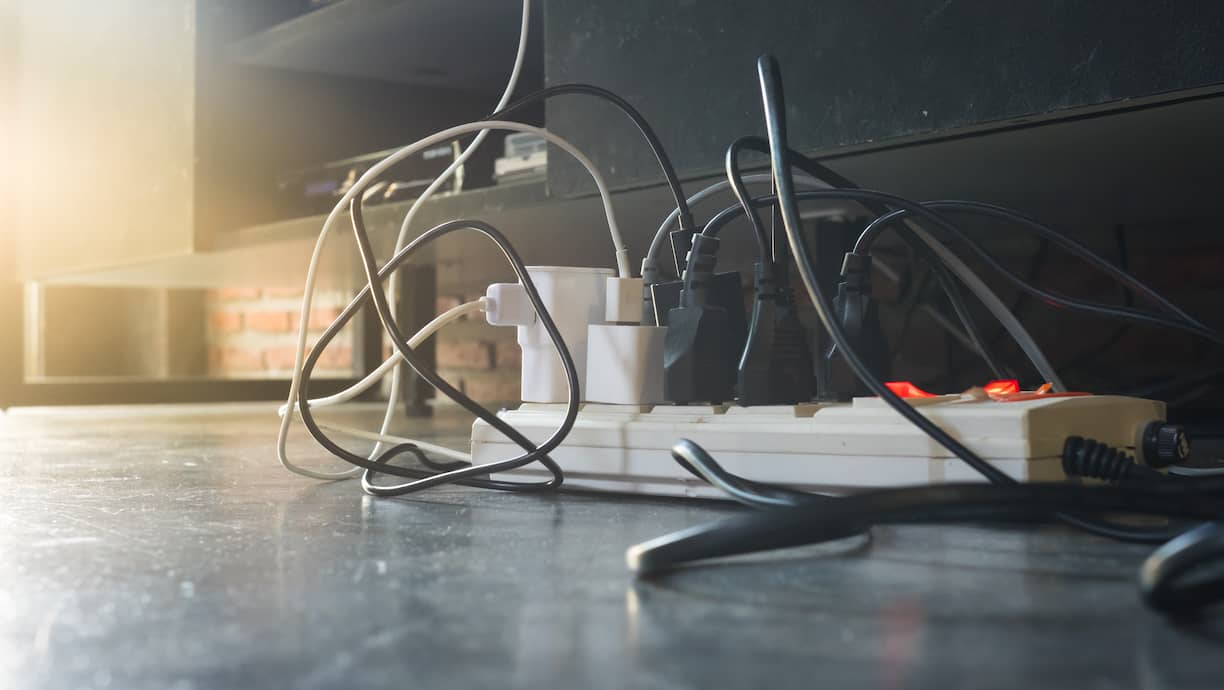Why Do Power Cables Matter?

Those of us bitten by the audiophile bug in the digital age tend to follow different paths to becoming and growing as an audiophile. Due in part to the now ridiculous volume of information and opinion available online, one of the main jobs of a beginner audiophile is to feel out what of the multitudinous sources of information out there can be trusted.
There are conventional elements of the design of a HiFi system, like speaker placement, amplifier-speaker pairing and integration of subwoofers. These efforts produce large effects on a system, and it behooves the new listener to start their journey there.
But in the pantheon of audio dialogue online, there’s also a “periphery” side to the hobby that tends to sketch out the newbies. I’m talking about things like beeswax fuses, carbon fiber platforms, Schumann-frequency generators and basically anything that Bybee comes up with. The word Quantum can be a stumbling block for someone looking to graduate from a receiver-based setup and get serious about the audio hobby.
That’s not to say the periphery products don’t work, but in general their effects won’t be enjoyed unless the more conventional work is done correctly. There’s an adage that goes along with these things, freely espoused by experienced audiophiles online, that “If you can’t hear the difference, good for you! You get to save your money.”
In my time doing this crazy audiophile thing, I traveled that path. As time went on, I opened my acceptance of these periphery products a little at a time. It began to make sense to me that speaker cables make a difference — it’s the high-current connection between the two most important elements of a system. Later, I learned more about the way cables work, including the effect of materials used. I learned about “skin effect” and eventually about RF performance in a system.
 |
| A visual representation of the "skin effect" on a solid-core conductor versus frequency. Photo courtesy Wikipedia Commons |
But it still took me years to accept the idea that a 6-foot “audiophile” power cable, at the end of miles and miles of distinctly non-audiophile wiring, would somehow make a difference in the sound of a system. When my engineer friend and HiFi mentor suggested that he believes the power cable to be the most essential — and his favorite — adjustment or “tweak” to a system, I was conflicted. This was the source of information I most trusted, yet this paradigm was still hard to wrap my head around.
That is, until I heard it. You see, our auditory systems are so complex and effective at discerning changes (and our audio passion leads us to work them out like a power lifter on steroids), that hearing is the ultimate in believing in the HiFi audio game. The further you go with this, the more in-tune you get with your system, so that a positive change witnessed can turn yours and my perspectives like the flick of a switch.
But… why do power cables make such a difference? After a ton of learning, including explorations of my own in various DIY power cable designs, I grew to understand the “why” of the power cable. After my own experiments, I also came to grips with a bit of the “what” and the “how.” Different cable geometries, different grounding schemes and various conductor materials all play a role in the sound of a power cable, as well as exactly where the cable is used.
Also along this journey, I discovered that using one type of power cable design throughout an entire system produces a type of clarity and depth of sound that simply wasn’t there when various approaches and methods were employed. Keep an eye out for a future blog on that subject.
I’m hoping this article will shed some light on what is a rather upper-level audiophile topic of discussion and illuminate for those new to the hobby what really shouldn’t be relegated to the periphery. Feeding our HiFi equipment power via the right kind of conduit should be closer within grasp for the new and intermediate audiophile alike.

Power Cables & Current Delivery
Even a new audiophile can understand the idea of bandwidth. A four-lane highway can handle four times the traffic of a single lane, and a drinking straw pales in comparison to the flow of a 2” water pipe. Other things in our lives inform us that the size of a wire relates directly to the amount of electrical current it can handle, and this is true: the bigger the cable, (i.e. the lower the gauge), the better.
But is that where the benefits of a better power cable end? Is a cable’s thickness the main determiner of quality, when placed in various locations around the system? I think you know the answer, which is absolutely not. I’ll explain with a quick example.
Say that a system consists of a source, a DAC, a preamplifier and an amplifier. Let’s toss an outlet distribution bar or a multi-outlet power conditioner in the mix. How many of these components will benefit from the extra current capability of using the biggest gauge power cable possible? On the surface, the answer should be only two out of the five. The reason for this is that with the exception of the amplifier, all of the components listed are “constant current” devices, with highly regulated power supplies. They draw the same amount of juice, no matter what.
In contrast, an amplifier has such an incredibly difficult job in the context of a system that its power supplies are mostly unregulated. Without going too deep into why that is, I’ll just say that an amp pulls instantaneous blasts of current from its supply (like an amplifier should) and wants no restrictions in place if it is to respond quickly, all throughout the audio spectrum.
The power strip (or conditioner or regenerator), as it powers the whole system, is influenced by the amp’s needs, which is why the answer above isn’t simply one device. So the next question is, do these constant current devices sound better with a bigger gauge cable feeding them? My experience says that all of these devices respond to a better-designed power cable, which often means a bigger gauge. But, it’s usually the other elements to the cable that play big in their circuits, rather than pure gauge and current delivery.
A well-designed power cable like those in Nordost’s Norse 2 series not only ups the gauge for most devices, but its design actually improves the transmission of energy, allowing for the best of both worlds. I'll use Nordost as an example, because they're very vocal about the reasoning and science behind their designs, and I've recently had a lot of listening experience involving Norse 2 cables, specifically the Heimdall 2.
This Nordost power cable uses solid conductors, and we know that solid conductors can handle instantaneous current draws much more effectively than stranded. But here’s the kicker - in any electrical signal, most of the energy travels outside of the conductors in the B, H, and E fields.
If you’ve not seen this recent, illuminating YouTube video on the matter, I urge you to pause right here and go watch it:
As it relates to power transmission, this topic underscores why the makeup of power cables matters just as much as the gauge to any and all audio devices. And also, why quality of design matters in power cables just as much, if not more, than all the other cables in the system. Nordost, a leader in audiophile cable technology for 30 years, has known that because energy travels in the magnetic fields outside of its wires, every piece of material involved from the conductor itself all the way to the edges of the magnetic fields surrounding the cable can influence the energy flow by way of absorption and loss.
Dielectric: The Cable's Capacitor
Plastic conducts electricity, and so does air. They just don't do it very well - especially air. They don't really conduct the type of current that we get from batteries, which is DC, but they will pass Alternating Current, or AC. To understand the importance of a dielectric, or jacket material which is closest to the power cable wire (which carries AC), we need to talk about capacitors.
In its basic form, a capacitor is two wires in a small can or box, separated by plastic. The type of plastic varies, because different plastics will transfer electricity with different charge-and-release characteristics. The size and distance of the plastic will determine how high the AC frequency must be to have a consistent flow.
Everything has a capacitance to a degree, and one reason out of the many that audiophiles like tubes over silicon-based solid state devices has, in some small part, to do with the fact that air separates the electrical elements in the tube, rather than silicon or plastic.
Capacitors are used to keep low frequencies and DC away from sensitive tweeters, and the larger the value of capacitor, the lower the frequency it will allow to pass.
Power AC is of course either 50Hz or 60Hz, which is a relatively low frequency, but when you consider the amount of material along an entire power cable's length, and the length itself, we're looking at a lot of plastic. This amount absolutely can come into play during power transmission, effectively leeching some of the energy away, storing it, and releasing it again into the same or nearby conductors.
Nordost introduced their Micro MonoFilament (MMF) technology in the Valhalla series in 1999. With that, the Connecticut-based company’s engineers solved what many cable makers still try to fight against even today. Nordost’s heavy silver plating of the solid conductors aims at the minuscule area between the wire and the next material, the “dielectric.” Their choice to use air rather than any other material as the dielectric extends this philosophy outward, and the use of a type of fluoropolymer plastic (similar to the well-known Teflon™) called FEP outside of those air layers as the only other material within those magnetic fields, finishes what they started.

Nordost's cable system is optimized for magnetic and electromagnetic field transmission with minimal loss, which is absolutely ideal for power cables and makes them a perfect example to help understand this subject.
OK, so let’s recap so far. Gauge, or more specifically the current ability of a power cable, matters. Choice of dielectric material and the type and shape of metal used in the live signal of the power cable matters to both signal efficiency and current capability. Is that it? Are we done?
I think you know the answer to that one, too. Not even close.

The Importance of Grounding
Since the days of Italy’s Guglielmo Marconi, inventor of the “wireless telegraph,” humans have been making waves — quite literally — all around the world. But it wasn’t until the recent inventions of WiFi, cell phones and advanced radio communications systems that our atmosphere became positively choked with high frequency, or radio waves. And it is not stopping any time soon, as high frequency bands previously occupied by militaries and governments are repeatedly released to the public for use, just as those entities move up to occupy new areas of the small-wave stratosphere on the heels of new technological advancements. We’re becoming more saturated with RF (radio frequency) with each passing year, and the issue of mitigation of influence from these waves in the functions of a finely-tuned audio system becomes more and more important as time goes on.
Add to this mess the fact that more switch-mode power supplies are added to the home with every new device, and you begin to see the issue. Switch-mode power supplies are small, cheap and cool-running, which is great for the environment, but less so for those concerned with ultimate audio fidelity. Now, to be fair, many audio devices also use these to power their circuits, with some of the best in HiFi even incorporating “power factor correction” to provide a really pure AC feed. But by nature of how they work, switch-modes do release some high frequency noise to the ground through what’s called a Y-capacitor connected to the filter banks, and our home ground networks must move this ground-borne noise out of the mix.

Why is RF bad for an audio system? Well, that’s simple. The collection of gear that comprises a stereo system, at its most basic description, deals with the movement of waves. That describes its food, its guts and its ultimate output. Sorry for that mental image. Compared to radio waves, the electric and mechanical sound waves (technically pressure waves — what we hear) almost appear as a straight line and not waves at all.
My previously mentioned audio buddy, while earning his EE degree long ago, was told by his RF professor that “sound is basically DC, man” — or something to that effect. And while he was joking with my friend, his words show an interesting perspective on the matter.
Our electronics are optimized for relatively low-frequency wave creation and amplification, and putting ourselves in the shoes of “audio waves,” each circuit makes a lot of sense. But let’s put ourselves in the shoes of a high-frequency wave, say 2.4MHz. Compared to audio, this frequency is extremely fast — that’s who we are. At that speed, our waves would wreak havoc on a typical audio circuit, because we don’t recognize anything about it. It’s not optimized for us, but you know what is? Big areas of metal, PCB board traces, loose (and lengthy) internal wiring, and many other elements commonly found in HiFi components.
That’s why we have our circuits in complete, metal enclosures. That’s why HiFi manufacturers create a “Faraday cage” for these sensitive internal components. And besides the safety aspect, it’s why our audio system grounding schemes, connected grounds and the earth ground wires of our power cables matter so much to the eventual sound.
From the RF perspective, an audio system of connected components is an archipelago of quasi-impenetrable Faraday cages, connected by the grounds of our interconnects and power cables. When all conditions are ideal, RF influence is collected, moved and ultimately drained, box-to-box, and out of the system via the home earth ground. Away it goes.
But this only works when the grounding scheme in this system is optimized for high frequency transmission. Excellent interconnect cables connect our devices to help flush the RF down the line. At the final cable before the wall, the ground prong of the power cable says sayonara to the high frequency waves.

That’s the optimum situation. But just as water will find the easiest way down a mountain, and it can be hard to guess exactly where it would flow unless you’re the actual water, many elements are at play to affect this movement. High-current pathways, like power cables, by their nature require special attention paid to the resistance (actually, with AC it's called "impedance") at every connection point of the journey to the wall outlet and eventually to the physical ground.
Looping back to our Nordost example, it is once again their choice of solid conductors, silver plating, dielectric material, connector quality and spacing of wires which do this job dutifully and masterfully. As Nordost engineers found, what's good for the audio signal is equally good for the grounding scheme. Pair this grounding-optimized approach with an excellent outlet that provides minimal impedance, and now we’re really performing the RF rejection job well.
That is why we want excellent power cables in our system. As all power cables in our example system above are plugged into one distributor or power strip, that is why the most important cable of any HiFi system is the very first one (or last one, depending on how you look at it) connected to the wall. It’s basically what engineers refer to as a “star ground” arrangement, forcing high frequency to collect at one common place. That’s why expensive distributors, which might offer minimal or no conditioning whatsoever, can still influence the sound of a HiFi system to a large degree.
Current ability, dielectric materials, and grounding scheme are the three major tenets of any excellent power cable, and thus a high-frequency-optimized power scheme. When this level of attention is applied throughout an entire system, the sonic effects can be absolutely staggering.
This paradigm of high attention paid to the incoming power and outgoing RF should not be confined to the periphery of the audio world — it’s simple, understandable science, and it significantly affects everything about the complex HiFi systems we build and love.
